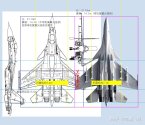Hello everyone,
I'd like to discuss an issue regarding the J-15. The J-15 has a major flaw: its 3x2 pylons, including the wingtip ones, are located on the outer, folding section of the wings. This means the J-15 cannot be armed with weapons unless its wings are unfolded, which severely impacts deck operational efficiency. In contrast, aircraft like the F/A-18 series and the F-35C have most of their hardpoints on the non-folding section. This results in the J-15 having only 6 "quick-load" hardpoints available in its folded state: the 2 under-intake pylons, 2 wing-root pylons, and 2 centerline fuselage pylons, in addition to the 6 non-quick-load pylons on the folding wing sections.
Furthermore, there's another issue: the non-folding wing-root pylons can interfere with the main landing gear, imposing restrictions on the shape of the munitions.
However, I recently saw a diagram showing that the J-15T (the catapult-capable variant) has further reduced the width of its folded airframe from 7.4m (on the Su-33/J-15) to 7.1m. Doesn't this exacerbate the problem? Is this diagram authentic? What could be the reason for such a modification?
I'd like to discuss an issue regarding the J-15. The J-15 has a major flaw: its 3x2 pylons, including the wingtip ones, are located on the outer, folding section of the wings. This means the J-15 cannot be armed with weapons unless its wings are unfolded, which severely impacts deck operational efficiency. In contrast, aircraft like the F/A-18 series and the F-35C have most of their hardpoints on the non-folding section. This results in the J-15 having only 6 "quick-load" hardpoints available in its folded state: the 2 under-intake pylons, 2 wing-root pylons, and 2 centerline fuselage pylons, in addition to the 6 non-quick-load pylons on the folding wing sections.
Furthermore, there's another issue: the non-folding wing-root pylons can interfere with the main landing gear, imposing restrictions on the shape of the munitions.
However, I recently saw a diagram showing that the J-15T (the catapult-capable variant) has further reduced the width of its folded airframe from 7.4m (on the Su-33/J-15) to 7.1m. Doesn't this exacerbate the problem? Is this diagram authentic? What could be the reason for such a modification?



